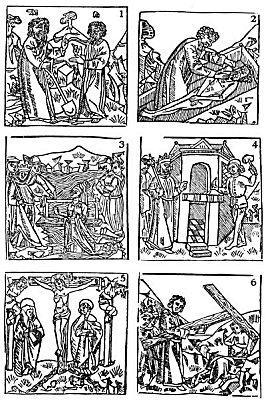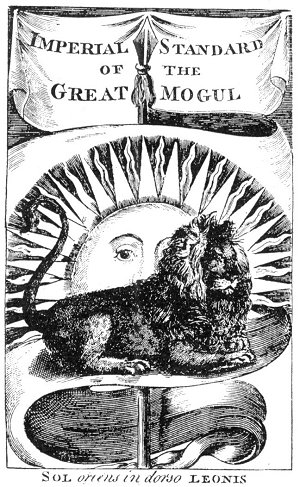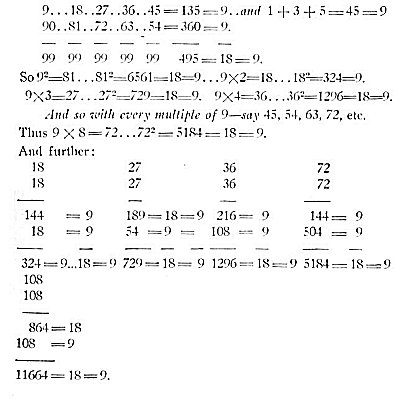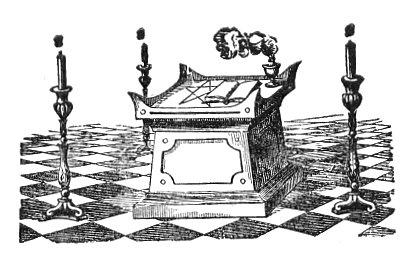p. 77
WHEN Solomon–the beloved of God, builder of the Everlasting House, and Grand Master of the Lodge of Jerusalem–ascended the throne of his father David he consecrated his life to the erection of a temple to God and a palace for the kings of Israel. David’s faithful friend, Hiram, King of Tyre, hearing that a son of David sat upon the throne of Israel, sent messages of congratulation and offers of assistance to the new ruler. In his History of the Jews, Josephus mentions that copies of the letters passing between the two kings were then to be seen both at Jerusalem and at Tyre. Despite Hiram’s lack of appreciation for the twenty cities of Galilee which Solomon presented to him upon the completion of the temple, the two monarchs remained the best of friends. Both were famous for their wit and wisdom, and when they exchanged letters each devised puzzling questions to test the mental ingenuity of the other. Solomon made an agreement with Hiram of Tyre promising vast amounts of barley, wheat, corn, wine, and oil as wages for the masons and carpenters from Tyre who were to assist the Jews in the erection of the temple. Hiram also supplied cedars and other fine trees, which were made into rafts and floated down the sea to Joppa, whence they were taken inland by Solomon’s workmen to the temple site.
Because of his great love for Solomon, Hiram of Tyre sent also the Grand Master of the Dionysiac Architects, CHiram Abiff, a Widow’s Son, who had no equal among the craftsmen of the earth. CHiram is described as being “a Tyrian by birch, but of Israelitish descent,” and “a second Bezaleel, honored by his king with the title of Father.” The Freemason’s Pocket Companion (published in 1771) describes CHiram as “the most cunning, skilful and curious workman that ever lived, whose abilities were not confined to building alone, but extended to all kinds of work, whether in gold, silver, brass or iron; whether in linen, tapestry, or embroidery; whether considered as an architect, statuary [sic]; founder or designer, separately or together, he equally excelled. From his designs, and under his direction, all the rich and splendid furniture of the Temple and its several appendages were begun, carried on, and finished. Solomon appointed him, in his absence, to fill the chair, as Deputy Grand-Master; and in his presence, Senior Grand-Warden, Master of work, and general overseer of all artists, as well those whom David had formerly procured from Tyre and Sidon, as those Hiram should now send.” (Modem Masonic writers differ as to the accuracy of the last sentence.)
Although an immense amount of labor was involved in its construction, Solomon’s Temple–in the words of George Oliver–“was only a small building and very inferior in point of size to some of our churches.” The number of buildings contiguous to it and the vast treasure of gold and precious stones used in its construction concentrated a great amount of wealth within the temple area. In the midst of the temple stood the Holy of Holies, sometimes called the Oracle. It was an exact cube, each dimension being twenty cubits, and exemplified the influence of Egyptian symbolism. The buildings of the temple group were ornamented with 1,453 columns of Parian marble, magnificently sculptured, and 2,906 pilasters decorated with capitals. There was a broad porch facing the east, and the sanctum sanctorum was upon the west. According to tradition, the various buildings and courtyards could hold in all 300,000 persons. Both the Sanctuary and the Holy of Holies were entirely lined with solid gold plates encrusted with jewels.
King Solomon began the building of the temple in the fourth year of his reign on what would be, according to modern calculation, the 21st day of April, and finished it in the eleventh year of his reign on the 23rd day of October. The temple was begun in the 480th year after the children of Israel had passed the Red Sea. Part of the labor of construction included the building of an artificial foundation on the brow of Mount Moriah. The stones for the temple were hoisted from quarries directly beneath Mount Moriah and were trued before being brought to the surface. The brass and golden ornaments for the temple were cast in molds in the clay ground between Succoth and Zeredatha, and the wooden parts were all finished before they reached the temple site. The building was put together, consequently, without sound and without instruments, all its parts fitting exactly “without the hammer of contention, the axe of division, or any tool of mischief.”

Moe is the founder of GnosticWarrior.com. He is a father, husband, author, martial arts black belt, and an expert in Gnosticism, the occult, and esotericism.





